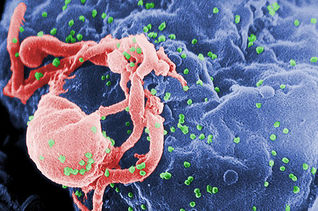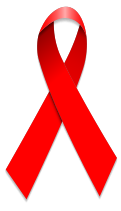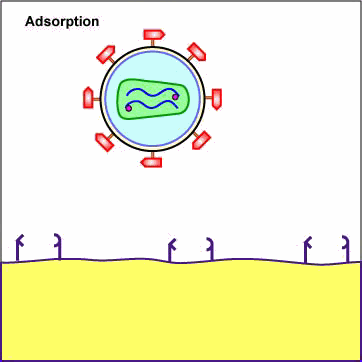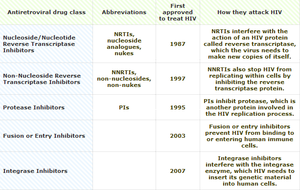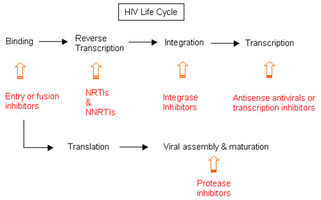DeAnza College/CIS2/Summer 2010/Group 5
| Students @ Work - a student collaborative writing project. Help us by providing feedback on the Discussion page. |
CIS 2 Computers and the Internet in Society SUMMER 2010 Final Projects
Contents
General History of AIDS/HIV
Human Immunodeficiency virus, otherwise known as HIV, is a virus that causes Acquired Immunodeficiency Syndrome, otherwise known as AIDS. HIV is spread from person to person through the transfer of bodily fluids. Four of the major ways of transmission of the virus are unsafe sex, contaminated needles, breast milk, and from mother to baby. It is believed that the HIV virus first appeared in the late 19th or early 20th century. It is generally believed by scientists that the disease originated in chimpanzees as they face a closely related virus.
The virus is believed to have originally reached the United States sometime in the late 1960's. The AIDS epidemic officially began on June 5th, 1981 when the U.S. CDCP (Center of Disease Control and Prevention) reported a case of pneumonia in five gay men in LA. By 1982, the CDC began calling the immune deficiency caused by HIV, AIDS. In 1983, doctors managed to isolate the strain that was believed to be the cause of AIDS. The disease began to garner national attention, especially in 1991 when NBA All-Star and now Hall of Famer Ervin "Magic" Johnson announced he was infected with HIV. [1]
There were many factors that contributed to the HIV epidemic in the 1980-1990's. Travel, blood donation and drug use are some of the factors. With international travel easier in the 1980's, many young men participated in the gay sexual revolution. In the USA, blood donation was in demand because of blood transfusions. Many donors were attracted to giving blood because of the cash; however, these donors included drug users. When HIV was first discovered, no one knew how easily the virus could spread. Blood screening was not available and with blood shipped worldwide, infected blood given to those in need would result in the victim becoming HIV positive. Drug users not only were donating infected blood which infected those in need, but with heroin easier to attain, the need for disposable plastic syringes was created. This created the demand for "shooting galleries" where drug users could rent equipment such as syringes which added the method of infection from needles.[2]
Myths
Myth: I can get HIV from being around people who are HIV positive.
Answer: Evidence has shown HIV is not spread through touch, tears, sweat or saliva. You can get it from infected blood, semen, vaginal fluid, or mother's milk.
Myth: I don't need to worry about becoming HIV positive, new drugs will keep me well.
Answer: Drugs have extended the lives of those who are HIV positive, but they do not provide a cure. Additionally, these treatments can be very expensive.
Myth: I can get HIV from mosquitos.
Answer: Several studies have shown no evidence to support this. When insects bite, they do not inject the blood of the person or animal they have last bitten.
Myth: Once you get HIV your life is over
Answer: The death rate was previously high, but due to awareness and new treatments, HIV positive people are living longer, healthier lives.
Myth: I'm straight and I don't do drugs, I won't get HIV.
Answer: While it's true most men get HIV through sexual contact with other men, 16% get it through heterosexual activity, while the number is 78% for women.
Myth: If you're receiving treatment for HIV, you can't spread the virus.
Answer: While treatment may eliminate most of the HIV strains in your blood, it still may be hiding in other parts of your body. Treatments may eliminate the appearance of the disease in blood tests, but it doesn't mean it's gone.
Myth: You can tell if you're HIV positive.
Answer: HIV can have a long incubation/dormant period. Thus many people may be HIV positive and not even know it. The only way to know is if you're tested.
Myth: I can't get HIV from oral sex.
Answer: While oral sex can be safer than other types of sex, you can still contract the virus by having oral sex with a man or woman who is infected.[3]
Status Of HIV/AIDS Today
As of 2008, it is estimated that more than 25 million people have died from HIV/AIDS since 1981. It is estimated that more than 33 million people are living with the disease. Of those 33 million, 31 million are adults and approximately 15.7 million are women. More than 2 million people died from the disease in 2008 alone. Approximately 1 million people in the U.S. are living with the disease today.Currently there is no cure for the disease. Education and awareness have been raised over the past few decades to help people understand and avoid contracting the disease. For those who have been infected with HIV, there is antiviral therapy that is available to help prevent the disease from developing into AIDS.
In a more recent development, the National Institute of Health announced that three new HIV antibodies had been discovered. These three antibodies were neutralizing up to 91% of all HIV strains. Before this, the most powerful antibodies were only effective against about 40% of all HIV strains. The man from whom the strains were discovered, so called Donor 45, has been living with the disease for over 20 years in good health. It is hoped that scientists will be able to develop a vaccine, or at least with the correct treatment, induce people to produce these three antibodies.
XVIII International AIDS Conference
The XVIII International AIDS Conference was held on July 18, 2010 to July 23, 2010 in Vienna Austria. This conference is held every two years for people researching AIDS, affected by AIDS, law makers, and activists. The next conference will be held July 22, 2012 to July 27, 2012 in Washington DC, USA. Developments from this year's conference include:
Focus on Prevention
Many researchers have focused studies on treating HIV to prevent both transmission and the full development of AIDS in the person's body. One study in British Columbia found that highly active antiretroviral therapy (HAART) could help reduce new transmissions by over 90%. [4]
Vienna Declaration
The Vienna Declaration is a petition that came out of this year's conference to end the failed war on drugs. The organization claims that the current method for fighting the war on drugs is not working and that scientific findings should be used when creating drug policy. Current policies in various countries exclude drug users, homosexual and bisexual men from treatment and can lead to the spreading of HIV. (The link for the pledge in in the Internet Resources section.)
Funding for Anti-Viral Therapy
The number of low- and middle-income people receiving anti-viral therapy has skyrocketed in the last decade, but due to the economy, funding has not kept pace. The Global Fund was supposed to collect money and distribute it to needy nations but looks to fall short of reaching its $20 billion goal before October 2010.[5]
United Nations Millennium Development Goals
In 2001, the 192 United nations member states agreed to work towards achieving eight goals by 2015. One of these goals is to Combat HIV/AIDS, malaria, and other diseases. Within this goal, there are two targets relating to HIV/AIDS:
- Target 6A: Have halted by 2015 and begun to reverse the spread of HIV/AIDS
- Target 6B: Achieve, by 2010, universal access to treatment for HIV/AIDS for all those who need it
As of 2010, progress has been made towards Target 6A to the point that it is now considered more of a chronic disease than a death sentence. The United Nations have not yet, however, achieved Target 6B, providing universal access to treatment for HIV/AIDS for all those who need it. There have been stronger calls to the international community to join together and provide affordable antiviral drugs universally. [6]
Combating HIV/AIDS
The Pathology, Immunology, and Virology behind HIV/AIDS
First, scientists need to understand the different stages of viral replication, and the underlying pathophysiology of the disease. HIV was found to be a retrovirus (specifically a lentivirus) with an RNA based genome [7], and required an enzyme called reverse transcriptase to transcribe viral RNA into DNA [8] It appears that HIV uses the lytic cycle of viral reproduction, when the host cell is told to abandon normal cellular function to produce new viruses, which then stream out of the cell, taking parts of the host cell membrane for its viral envelope; the constant degradation of the cell membrane causes the host cell to die.[9]The lytic cycle has 7 main steps: attachment, penetration, uncoating, synthesis, assembly and release. In attachment, the virus binds to a specific receptor on the cell membrane of the host cell. In penetration, the nucleocapsid is taken up by the cell; it is important to note that the viral genome is still not exposed to the cell cytoplasm. In uncoating, cellular enzymes work to remove the protective protein capsid, and integrate the viral genome into the host cell DNA. Following uncoating, synthesis of the viral elements occurs; this includes the formation of the capsid, and the replication of the viral genome. After uncoating, the various viral components need to be assembled, in the stage called assembly. This occurs in the cell’s cytoplasm. The final stage is release. Release can occur in one of two ways: either the cell bursts due to it filling with completed viruses, or there is a steady stream of viruses that leaves the cell through the membrane, taking pieces of the membrane with it. In either scenario, the host cell perishes.[10]
How to Treat HIV/AIDS
Should the viral replication cycle be stopped at any point prior to assembly, the disease can be warded off. Therefore, there are several targets which biotechnologists can focus on in order to combat the disease. As mentioned earlier, two human antibodies that are effective against 91% of HIV strains have been discovered.[11] Antibodies work by attaching to the virus, to prevent attachment to a host cell, or by marking the virus for destruction by macrophages.[12]Therefore, the initial step in the viral cycle would be prevented. Another method of impeding viral reproduction, especially in the case of retroviruses such as HIV, would be to use an enzyme inhibitor, one that is effective against reverse transcriptase. These inhibitors may have toxic side effects, however, and are generally not preferred treatments. [12][13] An alternative is a more targeted therapy, one that affects only the RNA in the viral genome. Biotechnologists can code an antisense RNA molecule, or an RNA molecule that is a mirror image of the viral genome. This mirror image can then bind to the genome, rendering it unusable by the virus.[14] A more recent finding is an inhibitor of HIV protease. HIV proteases help package the viral components into its infectious form; by obstructing this molecule, the viruses are rendered incapable of infecting other host cells.[12] A biotechnology and pharmaceutical company based in San Francisco, CA, called Gilead Sciences, recently unveiled a new vaginal gel that will be implemented in Africa. Initial testing and data analysis showed that the gel, mixed with the antiviral drug Tenofivir, proved effecting in protecting monkeys for up to 48 hours against the virus.[15] There are four main types of HIV/AIDS drugs, but none of them are cures; however, they do keep the patient from becoming ill for many years. These drugs must be taken everyday and many times taken with a combination of other anti-HIV drugs because HIV can quickly become resistant to one drug. Today some of the drugs are know as "Fixed dose combination" because of the combination of drugs into 1 pill reducing the number the patient needs to take everyday.[9]
Use of a protease inhibitor to treat HIV.
Effects of Novel Therapies and Future Plans
The effects of this new found research are staggering. The average life expectancy has increased dramatically. In 1996, when the disease was diagnosed, the average life expectancy was approximately 1-2 years, due to full-blown AIDS developing by the time treatment could be administered.[16][17] With these recent advances, doctors are increasingly finding that they can tell their patients that they have an almost normal life expectancy.[18] The CDC reports that the median age for those infected with HIV, in 2006, was 46 years, up significantly from 36 years in 1987.[18] In spite of all these advances, however, HIV, and the associated AIDS, remains one of the highest causes of death in people between 25 and 44 years of age. Moreover, the death rate from HIV has dropped by 80%, particularly with increased use of HAART, or highly active anti-retroviral therapy, indicating that new remedies are having an increased effect in controlling the disease. Advances such as the ones shown by Gilead Sciences are also going a long way in gaining a foothold on the disease spread; by targeting specific regions of the world, particularly Africa, which are particularly susceptible to the disease, the incidence rate of the disease should continue to drop. [15]
While these results are optimistic and hopeful, there are two main concerns that have yet to be fully addressed. First is the prevention aspect of HIV; whether it be through better sexual and family life education, or the creation of a vaccine to inoculate against the virus, there is still no way to medically prevent HIV. On July 13th, 2010, on the coattails of the NIH discovery, President Obama laid the groundwork for a national plan to combat the spread of HIV/AIDS. Thirty million dollars was allocated to help execute the strategy, which focuses on increasing the availability of testing, increased education about the disease, and improving existing efforts on disease prevention.[19]
The second point is treatment to cure the disease. The current antivirals in place for HIV only slow down the pace of the disease, but do not rid the individual of the affliction. There are 25 million people around the world currently affected by the disease; what is sorely needed is a method to end the suffering of these individuals.
The United Nations has recognized the important effect this disease is having on the global arena, and has thereby added eradicating AIDS to its agenda for global progress. The UN hopes to have made significant strides in its efforts to combat this disease by 2015. More information can be found here: http://www.un.org/millenniumgoals/
The Effect of the Computer on Designing Treatments
When the disease first started showing up in 1981, little was known about the structure of the virus. With advances in computer technology and successful integration of laboratory techniques with digital imaging, large strides have been made in determining the physical and chemical composition of different components of the HIV lentivirus. As HIV has a history of constant evolution, computers are being used extensively to predict and map out different viral configurations. As recently as May 4th, 2010, researchers have cultivated new ideas regarding the structure of HIV, and have made important contributions towards understanding how the virus can be countered. More specifically, the research has found that there are different versions of the Killer T-Cells which are the prey of choice for the virus. With the knowledge that the virus attacks these different forms of T-Cells at different times in the gestation of the disease, researchers can focus on developing targeted vaccines for those who are in different phases of HIV infection.[20]
Researchers are also comparing the genetic component of HIV to a computer query string. In other words, they can look at the RNA of HIV and relate it in terms of a computer science language, with inputs and outputs. Key to this angle is understanding how computers and biology can interact, a seemingly monumental task that was undertaken by Microsoft Corporation. Microsoft released code over a period of time in order to aid researchers in understanding why a specific HIV vaccine was actually making patients worse; in doing so they uncovered a "decoy" that had made it into the vaccine, and was actually attacking the human immune system. As research into combating the disease progresses, it becomes increasingly apparent that computers will play a significant role in aiding scientists as they fight against the spread of HIV.[21]
Prominent People in the Fight Against HIV/AIDS
Rock Hudson, his name evokes charm, good looks, romantic comedies with Doris Day and finally AIDS. Rock Hudson may not have been the first celebrity to die of AIDS, but his was by far, at the time, the most public and widely reported. His long-time friend, Elizabeth Taylor, stood by his side until his death and then was actively involved in the fight and cure for AIDS. She co-founded with Dr. Mathilde Krim, amfAR, The Foundation for AIDS Research. "Since 1985, amfAR has invested more than $307 million in its mission and has awarded grants to more than 2,000 research teams worldwide."[22] The amfAR web site offers the options of education, donation, and participation in the fight for a cure.[22] In 1991, Ms. Taylor went on to create her own foundation, The Elizabeth Taylor HIV/AIDS Foundation (ETHAF). Her foundation has a different mission than amfAR. Its mission is:
(1) support organizations delivering direct care and services to AIDS patients.
(2) support organizations that provide education to the public regarding the AIDS virus and the prevention of AIDS.
(3) support organizations conducting research to develop treatments and a cure for AIDS.
Mathilde Krim, Ph.D., in the early 80's, she was working at Sloan-Kettering Cancer Institute, in their Interferon Laboratory when the first cases of AIDS came through the lab. She recognized that the disease had the possibilities for serious, long-term consequences. She started the AIDS Medical Foundation (AMF) in 1985 and soon joined forces with Elizabeth Taylor to combine AMF and another organization into amfAR. Dr. Krim is the founding chairman. She was awarded the Presidential Medal of Freedom in 2000. [25][26]
If Rock Hudson gave AIDS a public face, Ryan White gave AIDS a human face. He was a hemophiliac teenager who had contracted HIV from a tainted blood transfusion. When he tried to go back to school, local parents and school officials tried to block his re-admittance. A major lawsuit followed. At the time, AIDS was widely misunderstood. The battle hit the news and became a national story. Elton John saw the story and met the family. He became a friend and, as Ryan's Mom describes him, their guardian angel. Elton John has credited Ryan White with changing his life. He has said that shortly after Ryan died, he became sober and has remained sober to this day. As mentioned above, Elton John has established two AIDS foundations to raise money, awareness and educate the public. Ryan White's mother created a foundation, the Ryan White Foundation to raise money and awareness in the fight against HIV/AIDS. In 1990, then Senators Edward Kennedy and Orrin Hatch sponsored the bill that became the Ryan White Care Act, in his honor. It is "the largest federally funded program for people living with HIV/AIDS". [27]
Earvin "Magic" Johnson, Hall of Fame NBA Basketball player. In 1991, Magic Johnson stunned the sports world with his announcement that he had tested positive for HIV. He contracted the disease due to his lifestyle (multiple sexual partners) while he was an NBA player. At the time, few people contracted HIV from heterosexual partners. He retired immediately but came back to play basketball on several different occasions before retiring (final) in 1996. He created his own foundation to raise awareness and fund-raise for a cure.Magic Johnson Foundation [28]
Arthur Ashe was the first African American to win Grand Slam titles in Tennis (US Open, Australian Open and Wimbledon) and helped the US Team to a Davis Cup title. In 1983, he had a second round of heart surgery to correct problems from his first heart surgery in 1979. During the second operation, he received tainted blood transfusions and contracted HIV/AIDS. He kept his condition private until 1992 when he was forced to make a public statement before the news media leaked the story. His worked for awareness and a cure for HIV/AIDS until his death in 1993. After his death, his alma mater, UCLA, built the Arthur Ashe Student Health and Wellness Center. His web site is http://www.arthurashe.org/site/. [29]
Internet Resources for HIV/AIDS
The internet has been utilized as a a strong resource in the fight against HIV/AIDS. Websites have been used to publish research findings, raise funding, and educate the masses. Below is a selection of some of the websites helping to fight HIV/AIDS today.
http://www.aidsresearch.org/, AIDS Research Alliance (ARA), this is the web site of the ARA, that for over 20 years has been working to find new drugs to treat and find a cure for HIV/AIDS. There are options to check out their research, join a clinical trial and make a donation. (No date on web site, however, there are news articles dated July 2010)
http://www.cdc.gov/hiv/, Department of Health and Human Services, Centers for Disease Control (CDC), this web site offers such services as Finding HIV/AIDS prevention and service providers, Daily News, Quick Links to free publications, conferences and training and a link for HIV/AIDS in Spanish. (The web site was updated on 7/20/10)
http://www.cdc.gov/hiv/, The CDC also offers Podcasts in both English and Spanish.
http://www.who.int/topics/hiv_aids/en/, The World Health Organization, this web site offers new HIV recommendations, general information, technical information publications and statistics in English, French, Spanish, Russian, Chinese and Arabic. (The web site doesn't have an update date but it does have a copyright date of 2010)
http://www.unaids.org/en/default.asp, Joint United Nations Programme on HIV/AIDS, the web site provides information on the International AIDS Conference, current news in the Press, updates on UN HIV/AIDS programs. The web site can be viewed in English, French, Spanish and Russian. (The web site doesn't have an update date. There are articles in the Press Centre dated in July 2010)
http://www.viennadeclaration.com, Vienna Declaration this is the official site of the Vienna Declaration from the AIDS Conference 2010. It gives everyone an opportunity to join the movement and endorse the Declaration. (The web site doesn't have a date, but it keeps score of the number of endorsements as of the date. As of August 1st, 2010 at 1:00 pm, there were 14,995 endorsements.)
http://www.aids2010.org/ AIDS Conference 2010 the official website of XVIII International AIDS Conference in Vienna, Austria.
http://www.avert.org/world-aids-day.htm, ADVERT web site for World AIDS Day. The next World AIDS Day (WAD) is December 1, 2010. The web site offers information, both written and video, on WAD. In their "What can I do" section, they offer games and quizzes to see how much you know about HIV and AIDS and opportunities to raise money and wear a red ribbon to raise awareness. (See ADVERT's web site below) (This web site was updated on 6/29/10)
http://www.blackaidsday.org/inside_index.html, National Black HIV/AIDS Awareness Day, this web site offers information on the National Black HIV/AIDS Day (which was 2/7/10) and options on how to support the day. (The web site's copyright is 2001-2010)
http://library.thinkquest.org/04oct/00924/games.html, Genesis of AIDS, This web site is sponsored by the Oracle ThinkQuest Education Foundation. It has several games, aimed at kids, to educate them on AIDS. (The web site doesn't have a date but it has all rights reserved as of 2004-2005)
http://www.avert.org/aids-hiv-prevention.htm, ADVERTing HIV and AIDS, ADVERT is an international AIDS charity that has HIV/AIDS educational lesson plans for the classroom. (The web site was updated 7/20/10)
http://www.onlinevolunteering.org/en/org/stories/index.html#8, UN Volunteers, Online Volunteering.org, this web site honors the efforts of online volunteers and also gives the opportunity to register and volunteer online. (The last entry was for the 2009 Volunteers.)
http://www.mgbala-agwa.org/online-volunteer-in-turkey-helps-build-hivaids-library-in-nigeria-armed-with-facts-villagers-work-to-halt-spread-of-epidemic/, Mgbala Agwa Youth Forum (MAYF), is the web site for the non-profit organization to raise HIV/AIDS awareness in Nigeria. They also offer the opportunity to do online volunteering. (The web site page has a copyright, but no date listed.)
http://www.redandblack.com/2010/07/27/aids-awareness-hits-facebook/, Red and Black.com is an independent student newspaper for the community of the University of Georgia. This article reports the community of Athens, Georgia is using Social Media, Facebook, to raise HIV/AIDS awareness in Northeast Georgia. (The article was submitted on 7/27/10)
http://www.youtube.com/results?search_query=aids+awareness+2010&aq=7, YouTube, this is the result from a YouTube search on AIDS Awareness 2010. There were 1,270 results to the search. The results included such entries as the First Baptist HIV/AIDS Singsation, the 2010 NJ National Day with Bishop Richard and the National Womens HIV/AIDS Awareness Day 2010.
http://www.ejaf.org/ and http://www.ejaf.com/Home, Elton John AIDS Foundation, the web sites for both Foundations (US ansd UK) were set up for education and awareness in the fight agains HIV/AIDS and to support those suffering with the disease against the discrimination they have faced. The combined organizations have raised $220 million since their inception (1992 & 1993). (The web site doesn't have a date, but the latest news entry is dated 7/13/10)
http://www.broadwaycares.org/Page.aspx?pid=195; Broadway Cares/Equity Fights AIDS, "is the nation's leading industry based HIV/AIDS fundraising and grant-making organization. We fund the social service work of the Actors Fund and award grants twice a year to AIDS service organizations nationwide." (The copyright on the web site is 2009)
http://blog.aids.gov/, this is the AIDS.gov blogspot
http://blogs.poz.com/, this is a blogspot for people living with AIDS to have their say
http://myjourneywithaids.wordpress.com/, Kenn Chaplin's journey with AIDS blog
http://www.aidslaw.ca/EN/about_us/index.htm, Canadian HIV/AIDS Legal Network, this web site "promotes the human rights of people living with and vulnerable to HIV/AIDS, in Canada and internationally, through research, legal and policy analysis, education and community mobilization." (The web site is copyrighted 2010)
Summary
In our project we've discussed the general history of HIV/AIDS, current status of HIV/AIDS, current research, and new drug treatments. We've also shown how the Internet has been used to raise awareness in the fight against HIV/AIDS by providing links to research organizations, fund-raising sites, sites with educational games, and podcasts. It's easy to see the impact of the Internet on HIV/AIDS by just using your favorite search engine and searching on such terms as "AIDS research", "AIDS awareness" and "drug treatments for AIDS", to name a few. Those involved in the cause have seen the power of the Internet and have created their own web sites to raise awareness, fund-raise, and offer support. This topic is important because American society has, in large measure, forgotten about HIV/AIDS. It seems that society thinks that because there have been breakthroughs with drug technologies and with the death rate slowing dramatically, that HIV/AIDS isn't something to be concerned about. Per the research we've shown above, that attitude is far from reality. The battle hasn't been won until there is a cure.
The UN has created eight Millennium Development Goals to change the world. One of those goals, to combat HIV/AIDS, as well as malaria & other diseases, is covered by this project. One of the target goals specifically stated by the UN in their report is to by 2015 to have halted and begun to reverse the spread of HIV/AIDS. In order to meet this goal, everyone involved in the fight against the disease needs to continue developing new technology that will aid this battle. We must also continue the education of those in the third world where information is not as readily available as it is in the United States. This is especially crucial in Africa, where a majority of the world's cases are found.[30]
References
- ↑ KFF Timeline, Kaiser Family Foundation. web. 2010. http://www.kff.org/hivaids/timeline/hivtimeline.cfm
- ↑ Avert. web. July 19th 2010. http://www.avert.org/origin-aids-hiv.htm
- ↑ WebMD. Debbie Bridges. Sept 19, 2009. http://www.webmd.com/hiv-aids/top-10-myths-misconceptions-about-hiv-aids
- ↑ Julio SG Montaner, "Association of highly active antiretroviral therapy coverage, population viral load, and yearly new HIV diagnoses in British Columbia, Canada: a population-based study" July 18th, 2010. http://www.thelancet.com/journals/lancet/article/PIIS0140-6736%2810%2960936-1/fulltext
- ↑ Ron Winslow, "A wrap up from the international aids conference in vienna" July 23, 2010. http://blogs.wsj.com/health/2010/07/23/a-wrap-up-from-the-international-aids-conference-in-vienna/
- ↑ Choi You-sun, "AIDS Considered Chronic Disease 30 Years After Initial Diagnosis" July 26, 2010. http://www.arirang.co.kr/News/News_View.asp?nseq=105261&code=Ne2&category=2/
- ↑ Douek, Daniel, Mario Roederer, and Richard Koup. "Emerging Concepts in the Immunopathogenesis of AIDS." Annual Review of Medicine 60.10 (2009): 471-84. Web. 24 Jul 2010. Retrived from http://www.ncbi.nlm.nih.gov/pmc/articles/PMC2716400/?tool=pmcentrez
- ↑ Silverthorn, Dee. Human Physiology: An Integrated Approach. 5th. San Francisco, CA: Pearson Education, 2010. 809. Print.
- ↑ 9.0 9.1 Viruses. N.p., n.d. Web. 24 Jul 2010. Retrieved from http://www.cbu.edu/~seisen/Viruses.htm
- ↑ Weeks, Benjamin, and Edward Alcamo. Microbes and Society. 2nd. Sudbury, MA: Jones and Bartlett, 2008. 124. Print.
- ↑ Sivitz, Laura. "NIH-Led Scientists Find Antibodies that Prevent Most HIV Strains from Infecting Human Cells." National Institute of Allergy and Infectious Diseases. NIH, 08 07 2010. Web. 24 Jul 2010. <http://www.niaid.nih.gov/news/newsreleases/2010/Pages/HIVantibodies.aspx
- ↑ 12.0 12.1 12.2 Renneberg, Reinhard. Biotechnology for Beginners. Elsevier, 2008. 141-142. Print.
- ↑ "Reverse Transcriptase Inhibitors." HealthLibrary. iHerb, 01 04 2009. Web. 24 Jul 2010. Retrieved from https://healthlibrary.epnet.com/GetContent.aspx?token=e0498803-7f62-4563-8d47-5fe33da65dd4&chunkiid=111797
- ↑ Ludwig, Linda. "RNA silencing and HIV: A hypothesis for the etiology of the severe combined immunodeficiency induced by the virus." Retrovirology 5.79 (2008): n. pag. Web. 24 Jul 2010. Retrieved from http://www.retrovirology.com/content/5/1/79
- ↑ 15.0 15.1 "Gilead Announces Initiation of NIH-Sponsored Phase I Trial to Evaluate Tenofovir Topical Gel as Preventive for Vaginal Transmission of HIV." Press Releases: Gilead. Gilead Life Sciences, 21 05 2002. Web. 24 Jul 2010. Retrieved from http://www.gilead.com/pr_1022011149
- ↑ Susman, Ed. "HIV Life Expectancy Now Normal." Terra Daily. Terra Daily, 25 08 2006. Web. 24 Jul 2010. <http://www.terradaily.com/reports/HIV_Life_Expectancy_Now_Normal_999.html
- ↑ "Life expectancy of individuals on combination antiretroviral therapy in high-income countries: a collaborative analysis of 14 cohort studies." Lancet 372.9635 (2008): 293-299. Web. 24 Jul 2010. <http://www.sciencedirect.com/science?_ob=ArticleURL&_udi=B6T1B-4T2DC93-14&_user=10&_coverDate=08/01/2008&_rdoc=1&_fmt=high&_orig=search&_sort=d&_docanchor=&view=c&_acct=C000050221&_version=1&_urlVersion=0&_userid=10&md5=1e9c8f56a7313541952fbea8e7a59241
- ↑ 18.0 18.1 "HIV Mortality." CDC. CDC, 28 07 2009. Web. 24 Jul 2010. <http://www.cdc.gov/hiv/topics/surveillance/resources/slides/mortality/
- ↑ Kellerhals, Merle. "Obama Announces New National HIV/AIDS Strategy." America. America.gov, 14 07 2010. Web. 24 Jul 2010. http://www.america.gov/st/scitech-english/2010/July/20100714162226dmslahrellek8.342922e-03.html
- ↑ Lin Hai. Retrieved from Lin, Hai, and J W Shuai. "A stochastic spatial model of HIV dynamics with an asymmetric battle between the virus and the immune system." New Journal of Physics 12. (2010): n. pag. Web. 1 Aug 2010. <http://www.sciencedaily.com/releases/2010/04/100429082347.htm>.
- ↑ Lemon, Summer. "Microsoft Takes Computer Science Into Fight Against HIV." PC World 06 Nov 2008: n. pag. Web. 1 Aug 2010. <http://www.pcworld.com/businesscenter/article/153465/microsoft_takes_computer_science_into_fight_against_hiv.html>.
- ↑ 22.0 22.1 amfar. 2010, amFAR history. http://www.amfar.org/amfar/history/
- ↑ ETHAF Mission. 2009. http://www.ethaf.org/our-mission
- ↑ Elizabeth Taylor. http://en.wikipedia.org/wiki/Elizabeth_Taylor
- ↑ Mathilde Krim. http://en.wikipedia.org/wiki/Mathilde_Krim
- ↑ amfAR. 2010 http://www.amfar.org/page.aspx?id=5554
- ↑ Ryan White. http://en.wikipedia.org/wiki/Ryan_White,/ref&gt;fckLRfckLR
- ↑ Magic Johnson. Retrieved from http://en.wikipedia.org/wiki/Magic_Johnson
- ↑ Arthur Ashe. Retrieved from http://en.wikipedia.org/wiki/Arthur_Ashe
- ↑ Millennium Development Goals Report. Web. 2010. http://www.un.org/millenniumgoals/pdf/MDG%20Report%202010%20En%20r15%20-low%20res%2020100615%20-.pdf
